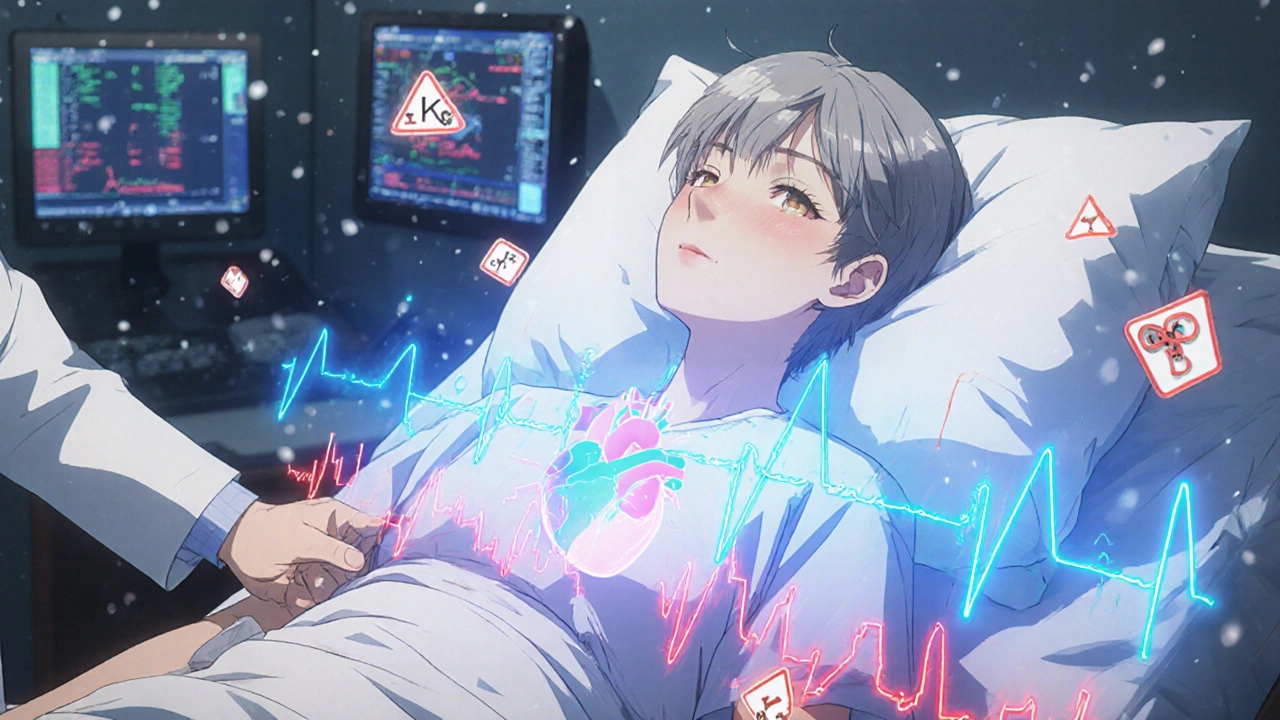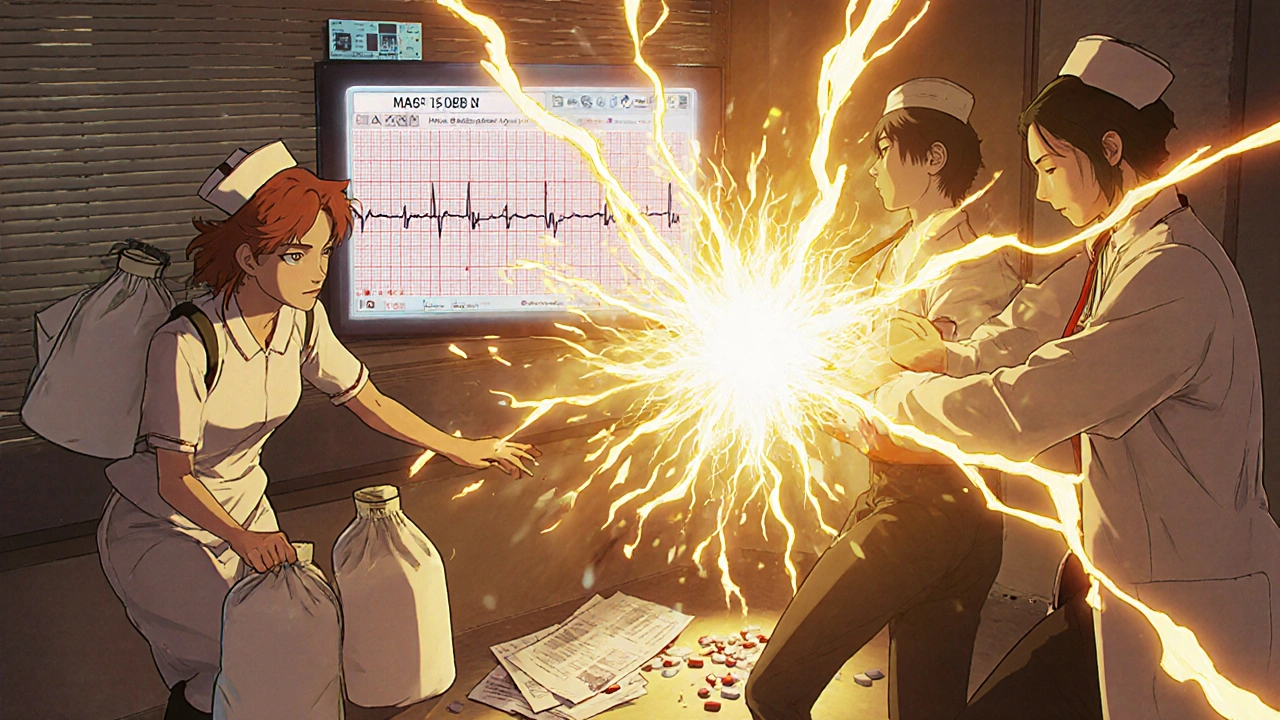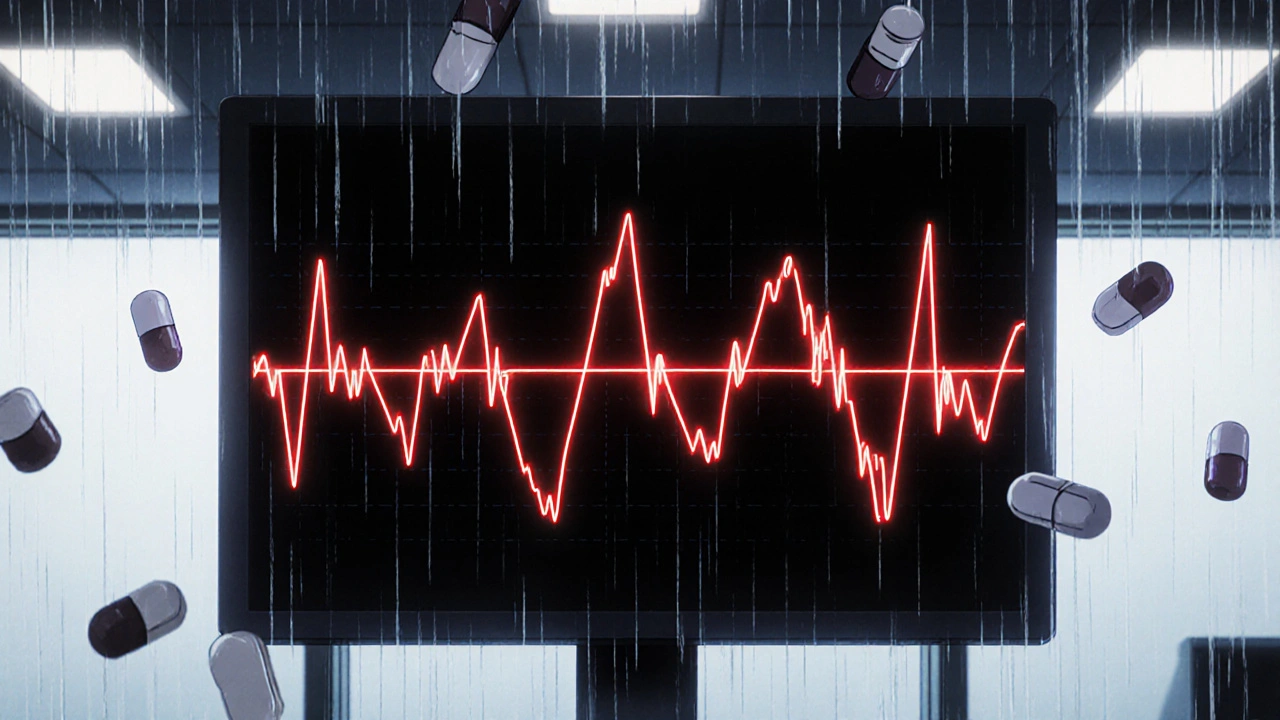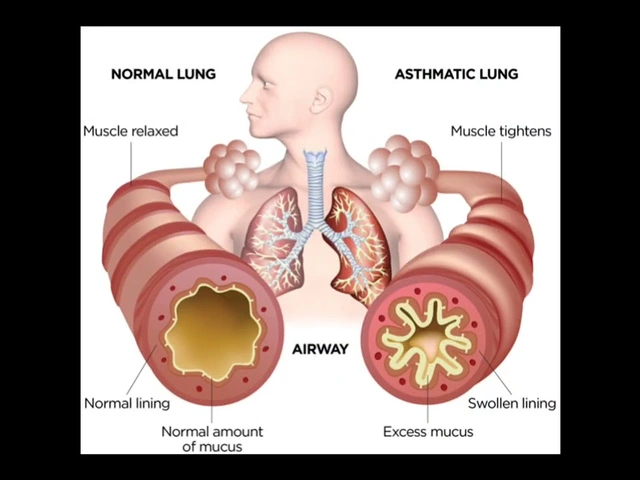QTc Interval Calculator
QTc Interval Calculator
Calculate your corrected QT interval to assess risk for Torsades de Pointes. Based on guidelines from the article.
Result
* Based on guidelines from the article. Not medical advice. Consult your healthcare provider for clinical decisions.
Every year, hundreds of people in the U.S. and Australia experience a sudden, dangerous heart rhythm called Torsades de Pointes-and most of them had no warning. It doesn’t come with chest pain or dizziness. Often, the first sign is a collapse. This isn’t a rare genetic disorder. It’s a side effect of medications many people take every day-antibiotics, antidepressants, anti-nausea pills, even pain meds. The good news? This deadly reaction is almost always preventable-if you know what to look for.
What Exactly Is Torsades de Pointes?
Torsades de Pointes (TdP) is a type of irregular heartbeat that shows up as a twisting pattern on an ECG. The name means "twisting of the points," which describes how the QRS complexes on the monitor seem to spin around the baseline. It’s not just any arrhythmia. It’s a specific, dangerous one that only happens when the heart’s electrical reset time-the QT interval-is too long. The QT interval measures how long it takes the heart’s lower chambers to recharge after each beat. When this time stretches too far, the heart muscle doesn’t recover properly. That’s when abnormal electrical sparks, called early afterdepolarizations, can trigger a chaotic rhythm. Left unchecked, TdP can turn into ventricular fibrillation-and death. The risk is real. About 4 out of every million women and 2.5 out of every million men will experience drug-induced TdP each year. And while that sounds small, the death rate jumps to 10-20% if it’s not stopped fast. What makes it scarier is that half the people who get it had no symptoms before it happened.Which Medications Can Trigger It?
Over 200 medications are linked to QT prolongation. Some are obvious culprits, like certain antiarrhythmics (sotalol, dofetilide). But many are everyday prescriptions:- Antibiotics: Erythromycin, clarithromycin, moxifloxacin
- Antidepressants: Citalopram, escitalopram (especially over 20 mg/day in older adults)
- Antipsychotics: Haloperidol, ziprasidone, thioridazine
- Antiemetics: Ondansetron (especially IV doses over 16 mg)
- Antifungals: Ketoconazole, voriconazole
- Pain management: Methadone (risk increases sharply above 100 mg/day)
Who’s Most at Risk?
It’s not just about the drug. It’s about the person taking it. Most TdP cases happen in people with one or more of these risk factors:- Female gender: Women make up 70% of cases-even when QT prolongation is similar to men’s.
- Age over 65: Nearly 7 out of 10 cases occur in older adults.
- Low potassium or magnesium: Potassium under 3.5 mmol/L triples the risk. Magnesium below 1.6 mg/dL increases it nearly threefold.
- Slow heart rate: Bradycardia (under 60 bpm) is present in over half of TdP cases.
- Multiple QT drugs: Taking two or more QT-prolonging medications doubles or triples the risk.
- Heart disease or kidney/liver problems: These affect how drugs are cleared from the body, leading to buildup.

How Do You Spot It Before It’s Too Late?
The key is prevention-not panic. Here’s what works:- Check the QTc before starting high-risk meds. A normal QTc is under 450 ms for men and 460 ms for women. Anything over 500 ms is a red flag. A rise of 60 ms or more from baseline is also dangerous.
- Test electrolytes. Low potassium and magnesium are easy to fix. Don’t start a QT-prolonging drug unless levels are normal.
- Review every medication. Use CredibleMeds.org to check if any drug on the patient’s list is flagged. Even OTC meds like antihistamines can add up.
- Watch for drug interactions. Clarithromycin and ketoconazole block liver enzymes that break down other drugs. That can cause citalopram or methadone to build up to toxic levels.
- Follow dosing limits. Citalopram should never exceed 40 mg/day-and only 20 mg if the patient is over 60. Ondansetron IV should never go above 16 mg. Methadone needs an ECG when starting and again if the dose crosses 100 mg/day.
What Happens If TdP Starts?
If someone collapses and an ECG shows Torsades de Pointes, time is everything. The first-line treatment is magnesium sulfate-1 to 2 grams given intravenously. It works in 82% of cases, even if potassium is normal. If that doesn’t work, the next step is pacing: raising the heart rate to over 90 bpm using temporary pacing or isoproterenol. Faster heart rates shorten the QT interval and stop the twisting rhythm. Don’t use antiarrhythmics like amiodarone-they make it worse. And never wait for symptoms. If the QTc is over 500 ms, don’t wait for the patient to feel dizzy. Stop the drug. Correct electrolytes. Monitor.
The Bigger Picture: Regulation and Future Tools
Since the 1990s, over a dozen drugs have been pulled from the market because of TdP risk-terfenadine, cisapride, grepafloxacin. Today, every new drug must be tested for QT effects before approval. That adds $1.2 million and 6-8 months to development. New tools are emerging. Mayo Clinic’s machine learning model uses 17 clinical factors to predict individual TdP risk with 89% accuracy. The CredibleMeds database updates monthly-adding new drugs, removing others. In September 2023, domperidone was downgraded from "Known Risk" to "Possible Risk" based on new data. The 2022 PREVENT TdP Act proposes mandatory ECG monitoring for high-risk drugs in hospitals and clinics. If passed, it could prevent 185-270 deaths a year. But the real win? Better awareness. The most preventable cases aren’t from bad drugs-they’re from missed electrolytes, ignored interactions, or skipping the baseline ECG.Bottom Line: Don’t Fear the Drug-Manage the Risk
No one should avoid a life-saving drug because of fear. But you also shouldn’t ignore the warning signs. Torsades de Pointes isn’t inevitable. It’s predictable. And it’s preventable. If you’re prescribing a QT-prolonging medication:- Check the patient’s electrolytes.
- Review all medications.
- Take a baseline ECG.
- Set a monitoring plan.
- Know your meds.
- Ask if your potassium and magnesium are checked.
- Report dizziness, palpitations, or fainting immediately.
Can Torsades de Pointes happen with just one medication?
Yes, especially in high-risk patients. Someone with low potassium, kidney disease, or a history of long QT syndrome can develop TdP from a single dose of a high-risk drug like citalopram or methadone. But most cases involve multiple risk factors-like a woman over 65 on three QT-prolonging drugs with low magnesium.
Is a long QT interval always dangerous?
Not always. A QTc of 470 ms in a healthy young person on a low-risk drug is usually fine. The danger comes when QTc exceeds 500 ms, or increases by more than 60 ms from baseline, especially with other risk factors like low potassium or slow heart rate. It’s the combination that turns a prolonged interval into a medical emergency.
What’s the difference between QT prolongation and Torsades de Pointes?
QT prolongation is an ECG finding-a longer-than-normal interval. Torsades de Pointes is the actual dangerous heart rhythm that can result from it. Think of QT prolongation as a warning light. TdP is the crash. Not everyone with a long QT gets TdP, but every case of TdP starts with QT prolongation.
Can I check my own QT interval at home?
No. Accurate QT measurement requires a 12-lead ECG interpreted by trained personnel. Consumer wearables like Apple Watch or Fitbit can detect irregular rhythms but cannot reliably measure QT intervals. If you’re on a high-risk medication, your doctor should order a baseline and follow-up ECG.
Are there any safe alternatives to QT-prolonging drugs?
Often, yes. For nausea, ondansetron can be replaced with metoclopramide (which has lower TdP risk). For depression, sertraline or fluoxetine may be safer than citalopram. For infection, amoxicillin can replace clarithromycin if appropriate. Always ask your doctor or pharmacist about alternatives-especially if you have risk factors.
How often should I get an ECG if I’m on methadone or citalopram?
For methadone: Get an ECG before starting, again when the dose exceeds 100 mg/day, and annually if stable. For citalopram: A baseline ECG is recommended before starting, especially if you’re over 60 or have heart disease. Repeat only if symptoms develop or if you’re on other QT drugs. Don’t get routine ECGs if you’re low-risk and on a safe dose.





I've seen this play out in the ER too many times. Patient comes in collapsed, family is freaking out, and we find out they were on citalopram + clarithromycin with a potassium of 3.2. No one checked the meds. No one checked the labs. It's not rocket science, but it's ignored constantly.
OMG YES. My grandma got TdP after a Z-Pack and a round of omeprazole. She was fine before. Docs just said 'oh it's just a side effect' like it's no big deal. She's lucky she didn't die. Please, if you're on any of these meds, ask for a basic electrolyte panel. It takes 5 minutes.
Let me tell you what they're not telling you. The FDA knows about this. The pharmaceutical companies know. But they don't want you to know because if everyone started checking QT intervals before taking antidepressants, sales would drop 40%. They'd rather you die quietly than lose a billion in revenue. And don't get me started on how the ECG machines are underfunded in rural hospitals. This is systemic. This is corporate murder disguised as medicine. They're testing drugs on old women because they know they won't complain. They're betting on your ignorance. And you're letting them win.
It's wild how something so lethal can hide behind a little blue pill you grab at CVS. I used to think 'heart stuff' was for old people or gym bros with dodgy supplements. Then I watched my cousin go from 'I'm fine' to code blue in 12 minutes because of a 40mg dose of citalopram and a bad kidney. The system's broken, but at least now I know to ask my pharmacist: 'Is this one of those QT killers?' Turns out, they know more than the docs sometimes.
thanks for this post i had no idea methadone could do this. my buddy is on it for chronic pain and he's always feelin' weirdly lightheaded. i'm gonna tell him to get his potassium checked. also i think i spelled potassium wrong but you know what i mean lol
While the data presented is statistically valid, the underlying epistemological framework is deeply flawed. You're conflating correlation with causality by attributing TdP solely to pharmacokinetic variables while ignoring the psychosocial determinants of cardiac arrhythmogenesis. The real issue is the neoliberal commodification of healthcare, wherein pharmaceutical capital externalizes risk onto vulnerable populations. Furthermore, the CredibleMeds database is a bourgeois construct-its classification schema is ontologically inconsistent and fails to account for genetic polymorphisms in CYP3A4 expression. Without genomic stratification, your 'preventive measures' are merely performative.
My cousin died from this and NO ONE warned us. I’m so mad. I keep thinking if I’d just asked one more question… I’ve been screaming about this on Facebook and my mom won’t stop crying. I just want someone to listen. Please don’t let this happen to your family. I’m still not sleeping.
Hey everyone, I’m a nurse in a small town in Ohio and I’ve been using this exact checklist for the past three years. We started asking every patient over 50 on antidepressants or antibiotics: 'What else are you taking?' and 'When was your last blood test?' We didn’t need fancy tech. We just needed to slow down. Since then, zero TdP cases in our clinic. Not one. And we’ve saved maybe 15 people from going to the ICU. It’s not glamorous. It’s not new. It’s just paying attention. If you’re a provider-do this. If you’re a patient-ask for it. We can fix this, one conversation at a time.
This article is dangerously oversimplified. You cite a 78% reduction in TdP cases without providing the confidence interval, sample size, or control variables. The VA data is retrospective and subject to selection bias. Moreover, the assertion that 'magnesium sulfate works in 82% of cases' is misleading-it only stabilizes the rhythm transiently; it does not address the underlying cause. Your recommendation to 'stop the drug' is clinically irresponsible without specifying the pharmacological half-life or alternative therapeutic options. This is not evidence-based medicine. It is alarmist triage advice masquerading as guidance.
Thank you for sharing this with such clarity. I’ve been working in a rural clinic in India where many patients are prescribed antibiotics and antifungals without any cardiac screening. The cost of ECGs is prohibitive, and awareness is low. Your breakdown of risk factors and alternatives is invaluable. I’ve printed this and shared it with our interns. We’re now starting to screen for potassium before prescribing ondansetron. Small steps, but they matter.
YESSSS this is so important!! 💙 I’m a pharmacist and I literally have a sticky note on my screen: 'Check QT drugs + K+ + Mg++' before you hit 'dispense'. I’ve caught so many dangerous combos-like someone on methadone + fluconazole + lisinopril. I just say 'Hey, let’s pause and check your labs' and 90% of the time they’re like 'Oh wow, I didn’t even know that was a thing.' We can save lives with a quick check. You got this. ❤️